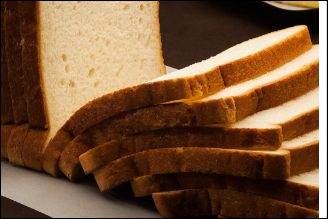
1. Bread and cakes
If you’ve ever wondered why your baked goods are non-elastic even when made with gluten which should result in gummy or chewy end product, wonder no more. Shortening is the culprit.
Why it is used: Shortening interferes with gluten formation in dough and is also used to keep the baked goods soft after baking. Unlike butter, which separates into oil and milk solids upon melting, shortening remains intact and reverts back to its soft, semi-solid state upon cooling. It is also preferred as it’s extremely shelf-stable and requires no refrigeration, is cheap, and has a higher smoking point than butter so food can be cooked quickly at high temperatures without burning the oil, which causes an unpleasant flavour. Its low moisture level reduces splatter, delays rancidity, and increases the stability of the fat, allowing it to be used repeatedly. Shortening will come up in your ingredient list by its name or as partially hydrogenated oil.
Harm caused: In addition to clogging your arteries and causing obesity, it increases your risk of metabolic syndrome.
2. Yoghurt
High Fructose Corn Syrup is a liquid sweetener alternative to table sugar used in many foods and beverages including bread, soda, candy, sweetened yoghurt, breakfast cereal, canned fruits, jam, jelly, nutrition bars, ice cream, sauces, boxed juice and energy drinks. This sweet poison is made from corn syrup and is found in practically everything.
Harm caused: It increases triglycerides, boosts fat-storing hormones, and drives people to overeat and gain weight.
3.Diet drinks
Artificial sweeteners are synthetic or natural alternatives to sugar which add virtually no calories to your diet thereby helping in weight control. Due to their intense sweetness, you need only a fraction of artificial sweetener compared with the amount of sugar you would normally use for sweetness. They also don’t contribute to tooth decay and cavities and since they aren’t carbohydrates they generally don’t raise blood sugar levels hence can be used to control diabetes.
They include saccharin, acesulfame, aspartame, neotame, and sucralose which are artificial and stevia the natural low-calorie sweetener.
Harm caused: But not all sweeteners are created equal. The artificial sweeteners may be even harder on our metabolic systems than plain old sugar. Artificial sweeteners have been linked to bladder cancer. Also when we turn to artificial sweeteners as a way to reduce calorie consumption, things get a bit tricky.
4. Tomato sauce and soda
Sodium Benzoate and Potassium Benzoate are preservatives sometimes added to soda and tomato sauce to preserve them by preventing mold from growing. But benzene is a known carcinogen that is also linked with serious thyroid damage. Dangerous levels of benzene can build up when plastic bottles of soda are exposed to heat or when the preservatives are combined with ascorbic acid (vitamin C).
5. Meat and chips
Stay informed. Subscribe to our newsletter
Monosodium glutamate (MSG) is a processed flavour enhancer that intensifies the meaty, savory flavour of food. While glutamates are present in some natural foods, such as meat and cheese, the ones exploited by the processed-foods industry are separated from their host proteins through hydrolysis.
MSG can be found in salty flavoured packaged snacks such as crisps and chips, frozen dinners, cold cuts, gravies, and ranch dressing.
High levels of free glutamates have been shown to seriously screw with brain chemistry causing brain damage. It is claimed to also cause asthma, excessive sweating, flushing of the skin, a tingling sensation in the skin, and headaches. Its side effects are also known as the Chinese restaurant syndrome as it is well known to be used in restaurants that serve Chinese food.
6. Chewing gum
Butylated Hydroxyanisole (BHA) is a potentially cancer-causing preservative that can be found in crisps, butter, cereal, preserved meat, beer, baked goods, dry beverage and dessert mixes, chewing gum, and other foods. It’s also found in food packaging and cosmetics.
When fatty or oily foods are treated with BHA, or its chemical cousin BHT (butylated hydroxytoluene), the preservatives occupy the attention of attacking oxygen molecules in a process chemists refer to as “scavenging free radicals.” The result is that the food tastes better for longer and prevents spoilage and food poisoning. But it’s a major endocrine disruptor and can seriously mess with your hormones.
7. Vegetable oil
Used together with BHA and BHT, is Propyl gallate. a preservative, used to prevent fats and oils from spoiling, and might cause cancer. It’s used in vegetable oil, meat products, potato sticks, chicken soup base and chewing gum.
8. Hot dogs and bacon
Sodium Nitrates and Sodium Nitrites are preservatives used to extend the life of meats, and to prevent the growth of bacteria. They are found in processed meats like bacon, and hot dogs. They’re believed to cause colon cancer and metabolic syndrome, which can lead to diabetes. How? You ask. When you eat Sodium nitrite nitrosamines are formed. These dangerous compounds are highly carcinogenic.
9. Unnaturally coloured foods
The artificial colours blue 1 and 2, green 3, citrus red 3, red 3, red 40 and yellow 5 and 6 have been linked to thyroid, adrenal, bladder, kidney and brain cancers.
They are found in baked goods, coloured beverages, ice cream, desert powders, candies, cereal, drugs, pet food, lipsticks and other products.
 The Standard Group Plc is a
multi-media organization with investments in media platforms spanning newspaper
print operations, television, radio broadcasting, digital and online services. The
Standard Group is recognized as a leading multi-media house in Kenya with a key
influence in matters of national and international interest.
The Standard Group Plc is a
multi-media organization with investments in media platforms spanning newspaper
print operations, television, radio broadcasting, digital and online services. The
Standard Group is recognized as a leading multi-media house in Kenya with a key
influence in matters of national and international interest.
 The Standard Group Plc is a
multi-media organization with investments in media platforms spanning newspaper
print operations, television, radio broadcasting, digital and online services. The
Standard Group is recognized as a leading multi-media house in Kenya with a key
influence in matters of national and international interest.
The Standard Group Plc is a
multi-media organization with investments in media platforms spanning newspaper
print operations, television, radio broadcasting, digital and online services. The
Standard Group is recognized as a leading multi-media house in Kenya with a key
influence in matters of national and international interest.









